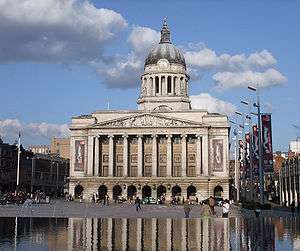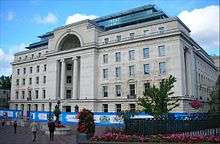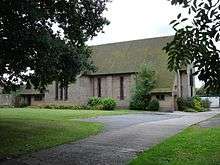Thomas Cecil Howitt
| Thomas Cecil Howitt | |
|---|---|
| Born |
June 6, 1889 Watnall Road, Hucknall, Nottinghamshire |
| Died |
September 3, 1968 (aged 79) Orston, Nottinghamshire |
| Occupation | Architect |
| Practice | Associated architectural firm[s] |
| Buildings | Nottingham Council House |
Thomas Cecil Howitt, OBE (6 June 1889 - 3 September 1968) an eminent British provincial architect of the 20th Century, was born at Hucknall, near Nottingham.
Howitt is chiefly remembered for designing prominent public buildings, such as the Council House and Processional Way in Nottingham, Baskerville House in Birmingham (first phase of the unrealised Civic Centre scheme), Newport Civic Centre, and several Odeon cinemas (such as Weston-super-Mare and Bristol). Howitt’s chief architectural legacies are however, in his home city of Nottingham. He was Housing Architect for the City Council, designing municipal housing estates which are often considered to be among the finest in terms of planning in the country.
Early years
Howitt was educated at Nottingham High School, leaving in 1904 to be apprenticed to the prominent Nottingham architect, Albert Nelson Bromley.[1] Bromley was architect to the Nottingham School Board and did extensive work for the Boots Company. In 1907, Howitt studied briefly at the Architectural Association School in London. He later opened a London branch office for Bromley, before returning to the Nottingham office until 1913.
Following a study tour of Europe in early 1914, Howitt was invited to become the company architect for Boots, however, the war soon intervened. Howitt was commissioned in November 1914, rising to the rank of Lieutenant-Colonel in the Leicestershire Regiment. He was awarded the Distinguished Service Order and French Croix de Guerre, as well as a Chevalier of the Legion d'Honneur (for action at the Battle of the Marne). Howitt was demobilised with the rank of Major in October 1919, and joined the City Engineer's Department at Nottingham City Council.
Architectural career
In 1926, Howitt’s rising status in the profession was marked by election as a member of the RIBA Council. The following year, he made a study tours of the USA and Canada and in 1928 to Denmark and Sweden (where he saw Stockholm Town Hall-writing an article about it for the local Nottingham Guardian).
As work on the Council House came towards completion, Howitt wished to set up his own practice, and after being asked to stay in post until a suitable successor could be appointed, he established an office in Exchange Buildings in December 1930.
Major architectural works
 The Council House, Nottingham
The Council House, Nottingham Baskerville House, Birmingham
Baskerville House, Birmingham Newport Civic Centre
Newport Civic Centre Nottingham & District Technical College
Nottingham & District Technical College
 Odeon Cinema, Weston-super-Mare
Odeon Cinema, Weston-super-Mare Birmingham Municipal Savings Bank - Broad Street Head Office
Birmingham Municipal Savings Bank - Broad Street Head Office St Barnabas Church, Lenton Abbey, Nottingham
St Barnabas Church, Lenton Abbey, Nottingham Home Brewery, Daybrook, Nottingham
Home Brewery, Daybrook, Nottingham
- Approximately 6000 municipally-owned houses for rent, Nottingham (1919–30)
- Council House, Exchange Buildings and Processional Way, Nottingham (1924–29)
- Raleigh Cycle Company Head Office, Lenton Boulevard, Nottingham (opened 1931) - awarded RIBA Bronze Medal 1933
- Home Brewery Head Office, Mansfield Road, Daybrook, Nottingham
- Woolwich Equitable Building Society, South Parade, Nottingham
- Martin's Bank, Market Street, Nottingham (1930)
- St. Mary's Church, Wollaton Park, Nottingham (1937–39)
- St. Barnabas' Church, Lenton Abbey, Nottingham (1937–39)
- Staythorpe 'A' Power Station, near Newark, Notts (from 1946) - awarded RIBA Bronze Medal 1953, now demolished
- Nightingale Hall, University of Nottingham (1946–56)
- Portland Building, University of Nottingham (1951–56)
- Nottingham & District Technical College (now Newton Building, Nottingham Trent University), Burton Street, Nottingham (1956–58)
- Baskerville House, Centenary Square, Birmingham (1935–39)
- Birmingham Municipal Bank Head Office, Broad Street, Birmingham (1931–34)
- Civic Centre, Newport, Monmouthshire (1936–1967)
- Odeon Cinema, Warley, Worcestershire (exterior only - 1934)
- Odeon Cinema, Weston-super-Mare (opened May 1935) Grade II listed
- Odeon Cinema, Clacton-on-Sea, Essex (opened May 1936)
- Odeon Cinema, Bridgwater, Somerset (opened July 1936)
- Odeon Cinema, Bristol (opened July 1938)
Selected unbuilt designs
- Civic Centre, Yeovil, Somerset (1938–39) - works cancelled by war.
- Head Office, British Electricity Authority, Bramcote, Nottingham (1956)
Later years
Howitt was actively involved in RIBA matters during the 1950s; effectively leaving the practice in the hands of partners Philip Gerrard and Frederick Woolley. Indeed, the name of the practice was changed to Cecil Howitt & Partners in 1948. Howitt retired from architectural practice in April 1962.
Cecil Howitt died aged 79 in September 1968; in the house he designed for himself, in the village of Orston, Nottinghamshire.
References
- ↑ Harwood, Elain. "Howitt, (Thomas) Cecil". Oxford Dictionary of National Biography website. Oxford University Press. Retrieved 11 October 2014.
- Beckett, John; Brand, Ken (2004). The Council House, Nottingham and Old Market Square. Nottingham: Nottingham Civic Society. ISBN 1-902443-09-8.
- Pevsner, Nikolaus (1979). Nottinghamshire (2001 2nd rev. ed.). New Haven, Connecticut: Yale University Press. ISBN 0300096364.
- Scoffham, Ernie (1992). A vision of the city: the architecture of T.C. Howitt. Nottingham: Nottinghamshire County Council Leisure Services. ISBN 0-900943-44-0.
External links
- Nottingham Civic Society: Comparing Nottingham Council House and the Stockholm City Hall (2004)